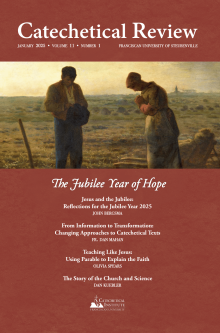
One of the hallmarks of a Jubilee Year is a pilgrimage to the tombs of Saints Peter and Paul in Rome. But what is a pilgrimage? It is harder to define than one might think. Throughout history, men, women, and children have traveled for a variety of reasons, often for motivations other than simple relocation or practical needs. We can see a type of intentional, spiritual travel in the history of the Greeks, the Egyptians, and the Romans.
The term “pilgrim” comes from the Latin peregrinus, meaning “traveler” or “one from abroad.” Americans might initially think of the Mayflower before they think of Santiago de Compostela in Spain or Chartres in France. A pilgrim, however, is not just any traveler. A pilgrim is one seeking God. Pilgrimages are spiritual journeys: tangible, outward signs of an inward desire to move towards conversion and growth in holiness. All major religions have an understanding of this interior need to physically move toward a sacred location.
History of Pilgrimage
Our Christian pilgrimages have deep Jewish roots. Three times a year, Jewish males were commanded to go to the temple in Jerusalem to celebrate the great pilgrimage feasts of Passover, Pentecost, and Sukkot (see Dt 16:16). They would travel from wherever they had settled to be near the holy place where God dwelt with his people. Soon after the time of Christ, Christians began traveling to Jerusalem to walk in the footsteps of Christ and to pray where he died and rose again. Some, like St. Jerome and St. Paula, went on pilgrimage and never returned home, settling in the Holy Land to be close to these places.
When the Holy Land later became too dangerous for travel, Christians began making pilgrimages closer to home, walking to the tomb of St. James in Spain or even constructing small shrines to the events of the Passion in their gardens and churches. The practice of the Stations of the Cross came from a desire to make pilgrimage even when it was impossible to travel to the Holy Land.
In a sense, pilgrimages to Rome began right after the death of Peter. Local Christians cared for his grave, building a small shrine over it, touching belongings to it, and asking his intercession. Even if these people only came from across town, they were pilgrims—a pilgrimage depends not on distance but on disposition. After Constantine constructed his magnificent basilicas over the tomb of Peter on Vatican Hill and the tomb of Paul on the Via Ostiensis, Christians throughout the empire could flock to these sacred places in safety.
The rest of this online article is available for current Guild members.
Art Credit: Ryan Day, Flickr.com.
This article is from The Catechetical Review (Online Edition ISSN 2379-6324) and may be copied for catechetical purposes only. It may not be reprinted in another published work without the permission of The Catechetical Review by contacting [email protected]
















